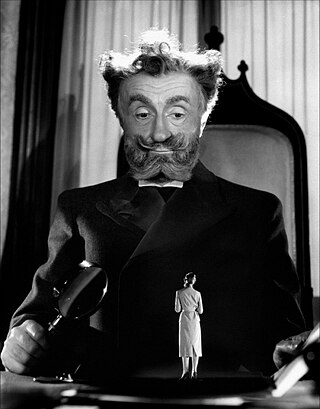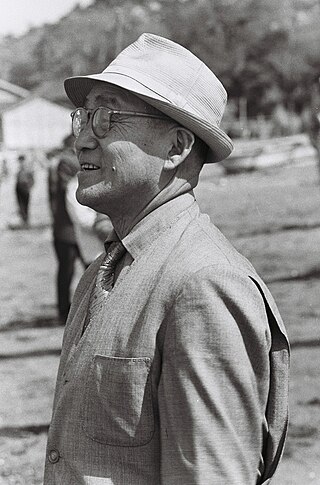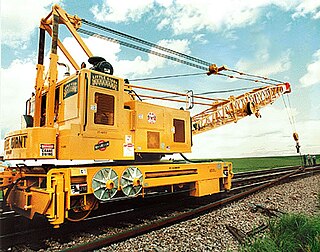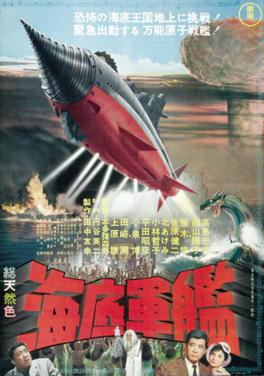
Special effects are illusions or visual tricks used in the theatre, film, television, video game, amusement park and simulator industries to simulate the imagined events in a story or virtual world. It is sometimes abbreviated as SFX, but this may also refer to sound effects.

Eiji Tsuburaya was a Japanese special effects director, filmmaker, and cinematographer. A co-creator of the Godzilla and Ultraman franchises, he is considered one of the most important and influential figures in the history of cinema. Tsuburaya is known as the "Father of Tokusatsu", having pioneered Japan's special effects industry and introduced several technological developments in film productions. In a career spanning five decades, Tsuburaya worked on approximately 250 films—including globally renowned features directed by Ishirō Honda, Hiroshi Inagaki, and Akira Kurosawa—and earned six Japan Technical Awards.

Steadicam is a brand of camera stabilizer mounts for motion picture cameras invented by Garrett Brown and introduced in 1975 by Cinema Products Corporation. The Steadicam brand was acquired by Tiffen in 2000. It was designed to isolate the camera from the camera operator's movement, keeping the camera motion separate and controllable by a skilled operator.

A crane is a machine used to move materials both vertically and horizontally, utilizing a system of a boom, hoist, wire ropes or chains, and sheaves for lifting and relocating heavy objects within the swing of its boom. The device uses one or more simple machines, such as the lever and pulley, to create mechanical advantage to do its work. Cranes are commonly employed in transportation for the loading and unloading of freight, in construction for the movement of materials, and in manufacturing for the assembling of heavy equipment.

A camera operator, or depending on the context cameraman or camerawoman, is a professional operator of a film camera or video camera as part of a film crew. The term "cameraman" does not necessarily imply that a male is performing the task.

In the United States, Canada and the United Kingdom, grips are camera support equipment technicians in the filmmaking and video production industries. They constitute their own department on a film set and are directed by a key grip. Grips have two main functions: The first is to work closely with the camera department to provide camera support, especially if the camera is mounted to a dolly, crane, or in an unusual position, such as the top of a ladder. Some grips may specialize in operating camera dollies or camera cranes. The second function is to work closely with the electrical department to create lighting set-ups necessary for a shot under the direction of the director of photography.
Grips' responsibility is to build and maintain all the equipment that supports cameras. This equipment, which includes tripods, dollies, tracks, jibs, cranes, and static rigs, is constructed of delicate yet heavy duty parts requiring a high level of experience to operate and move. Every scene in a feature film is shot using one or more cameras, each mounted on highly complex, extremely expensive, heavy duty equipment. Grips assemble this equipment according to meticulous specifications and push, pull, mount or hang it from a variety of settings. The equipment can be as basic as a tripod standing on a studio floor, to hazardous operations such as mounting a camera on a 100 ft crane, or hanging it from a helicopter swooping above a mountain range.
Good Grips perform a crucial role in ensuring that the artifice of film is maintained, and that camera moves are as seamless as possible. Grips are usually requested by the DoP or the camera operator. Although the work is physically demanding and the hours are long, the work can be very rewarding. Many Grips work on both commercials and features.

In cinematography, a jib is any boom device used to mount a camera on one end, and a counterweight with camera controls on the other. In principle, it operates like a see-saw, with the balance point located closer to the counterweight, which allows the end of the arm with the camera to move through an extended arc. Typically a jib permits the camera to be moved vertically, horizontally, or a combination of the two. A small jib can be mounted on a tripod, but many larger, purpose-built jibs have their own support stands, often on wheels. Modern jibs are normally modular and can be assembled in various lengths.

A railway crane is a type of crane used on a railway for one of three primary purposes: freight handling in goods yards, permanent way (PW) maintenance, and accident recovery work. Although the design differs according to the type of work, the basic configuration is similar in all cases: a rotating crane body is mounted on a sturdy chassis fitted with flanged wheels. The body supports the jib and provides all the lifting and operating mechanisms; on larger cranes, an operator's cabin is usually provided. The chassis is fitted with buffing (UK) and/or coupling gear to allow the crane to be moved by a locomotive, although many are also self-propelled to allow limited movement about a work site.

A camera dolly is a wheeled cart or similar device used in filmmaking and television production to create smooth horizontal camera movements. The camera is mounted to the dolly and the camera operator and focus puller or camera assistant usually ride on the dolly to push the dolly back and forth. The camera dolly is generally used to produce images which involve moving the camera toward or away from a subject while a take is being recorded, a technique known as a "dolly shot". The dolly grip is the dedicated technician trained to operate the dolly by manually pushing it back and forth.

A telescopic handler, also called a lull, telehandler, teleporter, reach forklift, or zoom boom, is a machine widely used in agriculture and industry. It is somewhat like a forklift but has a boom, making it more a crane than a forklift, with the increased versatility of a single telescopic boom that can extend forwards and upwards from the vehicle. The boom can be fitted with different attachments, such as a bucket, pallet forks, muck grab, or winch.
Television crew positions are derived from those of film crew, but with several differences.
Rear projection is one of many in-camera effects cinematic techniques in film production for combining foreground performances with pre-filmed backgrounds. It was widely used for many years in driving scenes, or to show other forms of "distant" background motion.

Sympathy for the Devil is a 1968 avant-garde film shot mostly in color by director Jean-Luc Godard, his first British-made, English-language film. It is a composite film, juxtaposing documentary, fictional scenes and dramatised political readings. It is most notable for its scenes documenting the creative evolution of the song "Sympathy for the Devil" as the Rolling Stones developed it during recording sessions at Olympic Studios in London.

Atragon is a 1963 Japanese tokusatsu science fiction film directed by Ishirō Honda, with special effects by Eiji Tsuburaya. Produced and distributed by Toho, it is based on The Undersea Warship: A Fantastic Tale of Island Adventure by Shunrō Oshikawa and The Undersea Kingdom by Shigeru Komatsuzaki. The film stars Jun Tazaki, Tadao Takashima, Yōko Fujiyama, Yū Fujiki, and Ken Uehara.

A mobile crane is a cable-controlled crane mounted on crawlers or rubber-tired carriers or a hydraulic-powered crane with a telescoping boom mounted on truck-type carriers or as self-propelled models. They are designed to easily transport to a site and use with different types of load and cargo with little or no setup or assembly.

An operator is a professional designation used in various industries, including broadcasting, computing, power generation and transmission, customer service, physics, and construction. Operators are day-to-day end users of systems, that may or may not be mission-critical, but are typically managed and maintained by technicians or engineers. They might also work on a 24-hour rotating shift schedule.
Elevated photography is the process of taking aerial photos using a telescoping pole or mast, or other aerial or elevated support systems, to emulate aerial photographs, or video, taken from a commercially licensed aircraft.

Technocrane is a telescopic camera crane widely utilised in the film industry and in television production. Originally commissioned, manufactured, named and marketed by Technovision Ltd. in London, United Kingdom, the first TechnoCrane was exhibited by Technovision during Photokina Expo in Cologne, Germany in September 1986.

A jib or jib arm is the horizontal or near-horizontal beam used in many types of crane to support the load clear of the main support. An archaic spelling is gib.
In cinematography, remote heads, also known as 'hot' heads, or robos are motorized mechanical and/or electronic devices that are used as a mount for film, video or digital cinema cameras and can be controlled from a distance. In most cases this refers to control not only of the physical orientation of the camera body, such as pan (horizontal), tilt (vertical), roll, but also control over many or all camera functions – focus, zoom, color balance, gamma correction, camera menus and other related functions.

















